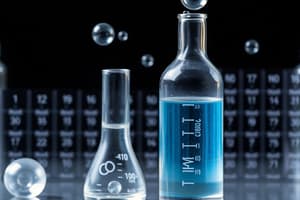Podcast
Questions and Answers
What is the relationship between thermal expansion and temperature?
What is the relationship between thermal expansion and temperature?
- Thermal expansion is not affected by temperature.
- Thermal expansion increases with increasing temperature. (correct)
- Thermal expansion decreases with increasing temperature.
- Thermal expansion is inversely proportional to temperature.
How can pressure be related to the state of matter?
How can pressure be related to the state of matter?
- Pressure is only related to temperature changes.
- Pressure remains constant regardless of the state of matter.
- Pressure varies depending on the state of matter. (correct)
- Pressure decreases as the state of matter changes.
What happens to the volume of a gas when pressure increases at constant temperature?
What happens to the volume of a gas when pressure increases at constant temperature?
- Volume increases.
- Volume fluctuates.
- Volume remains constant.
- Volume decreases. (correct)
How are ionic compounds classified based on their structure and bonding?
How are ionic compounds classified based on their structure and bonding?
Which statement best describes the difference between physical and chemical properties?
Which statement best describes the difference between physical and chemical properties?
How does the law of conservation of mass apply to chemical reactions?
How does the law of conservation of mass apply to chemical reactions?
What is the main difference between endothermic and exothermic reactions?
What is the main difference between endothermic and exothermic reactions?
Which type of energy resources are not renewable?
Which type of energy resources are not renewable?
Why are minerals and some natural resources not renewable?
Why are minerals and some natural resources not renewable?
In a chemical equation, which type of bond typically contains more energy?
In a chemical equation, which type of bond typically contains more energy?
What is the main difference between synthetic and natural materials?
What is the main difference between synthetic and natural materials?
What is the main focus of the described test?
What is the main focus of the described test?
How is thermal energy transfer defined in the context of the test?
How is thermal energy transfer defined in the context of the test?
Which concept involves determining compound models and chemical formulas for unknown compounds?
Which concept involves determining compound models and chemical formulas for unknown compounds?
What does the term 'porosity' refer to in the context of the test?
What does the term 'porosity' refer to in the context of the test?
How are changes of state described within the test?
How are changes of state described within the test?
What do vaporization, evaporation, and boiling point relate to in the context of the test?
What do vaporization, evaporation, and boiling point relate to in the context of the test?
Study Notes
Thermal Expansion and Contraction
- Thermal expansion: increase in volume of a substance due to an increase in temperature
- Thermal contraction: decrease in volume of a substance due to a decrease in temperature
- Volume-Temperature Law: as temperature increases, volume of a substance also increases
Pressure and State of Matter
- Pressure affects the state of matter: increases in pressure can cause a gas to become a liquid or a solid
- Daily life applications: scuba diving, compressed air, and pressure cookers
Pressure and Volume
- At constant temperature, an increase in pressure results in a decrease in volume
- Graphical representation: PV curve shows the relationship between pressure and volume
Models of Substance
- Classification of substances based on structure and bonding:
- Metal and nonmetal
- Ionic compounds
- Polar covalent compounds
- Molecules
Gases
- Types of gases:
- Pure element (individual atoms)
- Pure element (molecules)
- Compound molecules
- Properties of gases: expansion, diffusion, and compression
Physical Properties of Matter
- Measurement tools:
- Thermometer
- Barometer
- Hydrometer
- Physical properties:
- Density
- Melting point
- Boiling point
Physical and Chemical Properties
- Physical properties:
- Can be observed without changing the substance's composition
- Examples: density, melting point, boiling point
- Chemical properties:
- Can be observed only by changing the substance's composition
- Examples: reactivity, flammability
Physical and Chemical Change
- Physical change:
- Reversible change in state (e.g., solid to liquid)
- No change in composition
- Chemical change:
- Irreversible change in composition
- Examples: combustion, decomposition
Law of Conservation of Mass
- Mass is conserved in a chemical reaction
- Total mass of reactants = total mass of products
Endothermic and Exothermic Reactions
- Endothermic reactions:
- Absorb energy
- Temperature increases
- Bonds broken
- Exothermic reactions:
- Release energy
- Temperature decreases
- Bonds formed
Natural Resources
- Natural resources:
- Water
- Air
- Soil
- Minerals
- Human dependence on natural resources:
- Agriculture
- Industry
- Energy production
Renewable and Nonrenewable Energy
- Renewable energy:
- Solar
- Wind
- Hydro
- Geothermal
- Nonrenewable energy:
- Fossil fuels
- Nuclear
Minerals and Natural Resources
- Minerals:
- Nonrenewable
- Finite resources
- Examples: copper, iron, gold
- Methods to preserve minerals:
- Recycling
- Conservation
- Efficient extraction
Synthetic and Natural Materials
- Synthetic materials:
- Man-made
- Examples: plastics, fibers
- Natural materials:
- Derived from natural sources
- Examples: wood, cotton, silk
Studying That Suits You
Use AI to generate personalized quizzes and flashcards to suit your learning preferences.
Description
Test your knowledge on different states of matter (solid, liquid, gas) and their properties, as well as compound models and chemical formulas. Includes topics on energy content, particles movement, element ratios, and element percentages.




